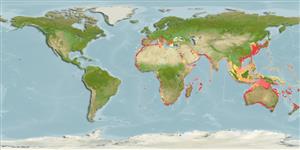Teleostei (teleosts) >
Anguilliformes (Eels and morays) >
Ophichthidae (Snake eels) > Ophichthinae
Etymology: Ophisurus: Greek, ophis = serpent + Greek, oura = tail (Ref. 45335).
More on author: Linnaeus.
Environment: milieu / climate zone / depth range / distribution range
Ecology
Marine; brackish; demersal; depth range ? - 300 m (Ref. 9563). Subtropical; 46°N - 41°S, 18°W - 179°E
Circumglobal: Atlantic (northern coast of Iberian peninsula to South Africa, also Madeira and western Mediterranean) and Indo-Pacific: southern Mozambique to South Africa; north to Japan, south to Australasia.
Size / Weight / Age
Maturity: Lm ? range ? - ? cm
Max length : 250 cm TL male/unsexed; (Ref. 3972); common length : 100.0 cm TL male/unsexed; (Ref. 3397)
Body olive green to brown above, paler below; head pores black; young silvery (Ref. 3972).
Inhabiting the continental shelf on sand or mud bottom (Ref. 4455). Buried with only its head exposed (Ref. 27121). Also found in estuaries (Ref. 9563).
Life cycle and mating behavior
Maturity | Reproduction | Spawning | Eggs | Fecundity | Larvae
Bauchot, M.-L., 1986. Ophichthidae (including Echelidae). p. 577-585. In P.J.P. Whitehead, M.-L. Bauchot, J.-C. Hureau, J. Nielsen and E. Tortonese (eds.) Fishes of the north-eastern Atlantic and the Mediterranean. volume 2. UNESCO, Paris. (Ref. 6522)
IUCN Red List Status (Ref. 130435: Version 2024-1)
Threat to humans
Harmless
Human uses
Fisheries: minor commercial; gamefish: yes
Tools
Special reports
Download XML
Internet sources
Estimates based on models
Preferred temperature (Ref.
123201): 13.4 - 27.4, mean 19.7 °C (based on 1148 cells).
Phylogenetic diversity index (Ref.
82804): PD
50 = 0.7500 [Uniqueness, from 0.5 = low to 2.0 = high].
Bayesian length-weight: a=0.00071 (0.00040 - 0.00124), b=2.97 (2.82 - 3.12), in cm total length, based on LWR estimates for this species & (Sub)family-body (Ref.
93245).
Trophic level (Ref.
69278): 4.1 ±0.7 se; based on size and trophs of closest relatives
Resilience (Ref.
120179): Very Low, minimum population doubling time more than 14 years (Preliminary K or Fecundity.).
Fishing Vulnerability (Ref.
59153): Very high vulnerability (90 of 100).
Nutrients (Ref.
124155): Calcium = 17.5 [4.7, 48.6] mg/100g; Iron = 0.692 [0.254, 2.830] mg/100g; Protein = 19 [17, 21] %; Omega3 = 0.272 [0.123, 0.723] g/100g; Selenium = 41.9 [11.4, 112.3] μg/100g; VitaminA = 4.34 [1.45, 12.72] μg/100g; Zinc = 0.534 [0.270, 1.002] mg/100g (wet weight);
